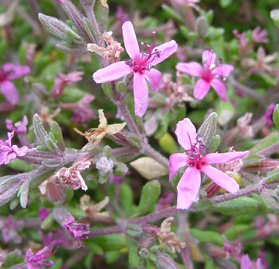Alkali Heath
Frankenia salina
Alkali Heath, a California native plant, is a low growing, perennial, woody subshrub. A halophyte, its common name reflects the plant’s preference for very alkaline soil.

Credit: Michael Charter. Used with permission
SPECIES IN DETAIL
Alkali Heath
Frankenia salina
CONSERVATION STATUS: Safe for Now
CLIMATE CHANGE: Not Applicable
At the Aquarium
Our plants were donated by the Stewards of the Los Cerritos Wetlands located in Long Beach, California.
Geographic Distribution
California: Great Central Valley, Central Coast, South Coast; Channel Islands, east of Sierra Nevada Mountains, and Mojave Desert. Occasionally found in Nevada. Introduced in Hawaii.
Habitat
These plants are usually found in the margins of the drier parts in the high marsh, in clay loam soil with a high salt content, and in alkali flats in the desert. Plants also occur on beaches. The plants, which prefer full sun, can tolerate salt and seasonal flooding.
Physical Characteristics
The jointed woody stems of alkali heath form a sprawling bushy shrub or clumps of vegetation that can be low lying to the ground or as tall as 38 cm (15 in) in different parts of the marsh, especially in the drier parts. Its reddish colored stems increase in diameter each year. Leaves are small, waxy, and somewhat fleshy. The leaves are sometimes rolled under. The lower leaves are egg-shaped while the upper leaves are narrow. They are about 1.3 cm (0.5 in) long. The leaves and stems are in opposite pairs, each pair rotated at right angles on the stem relative to the pairs immediately above and below. The small singular flowers are pink or purplish with five pointed petals. They do not have a stem.
Diet
Alkali heath obtains its nutrients through photosynthesis.
Reproduction
Alkali heath reproduces asexually by growth of rhizomes and sexually by seed germination. Flowers bloom from June to October. One to 20 brownish egg-shaped seeds that are 1-1.5 mm (0.039-0.059 in) long are contained in a 4.8 mm (0.19 in) capsule.
Behavior
These plants are stress deciduous, that is, the plants lose their leaves under certain conditions such as extreme drought.
Adaptation
Alkali heath plants are salt excretors. Special pores in the plants pump out salt water through the leaves. The sun evaporates the water and the salt crystals left behind become visible on the leaves.
Conservation
Alkali heath is one of the more common native plants found in the saltmarsh ecosystem. Although relatively safe now, human activities such as development and pollution are impacting their habitats. There are also concerns about future impacts that may be caused by sea level rises.
Special Notes
The nectar produced by alkali heath is a food source for insects. Invertebrates use this low, sprawling, bushy plant for shade and as a place to hide from predators.
Home gardeners plant alkali heath in their rock gardens because of its ornamental flowers and low sprawling behavior.
SPECIES IN DETAIL | Print full entry
Alkali Heath
Frankenia salina
CONSERVATION STATUS: Safe for Now
CLIMATE CHANGE: Not Applicable
Our plants were donated by the Stewards of the Los Cerritos Wetlands located in Long Beach, California.
California: Great Central Valley, Central Coast, South Coast; Channel Islands, east of Sierra Nevada Mountains, and Mojave Desert. Occasionally found in Nevada. Introduced in Hawaii.
These plants are usually found in the margins of the drier parts in the high marsh, in clay loam soil with a high salt content, and in alkali flats in the desert. Plants also occur on beaches. The plants, which prefer full sun, can tolerate salt and seasonal flooding.
The jointed woody stems of alkali heath form a sprawling bushy shrub or clumps of vegetation that can be low lying to the ground or as tall as 38 cm (15 in) in different parts of the marsh, especially in the drier parts. Its reddish colored stems increase in diameter each year. Leaves are small, waxy, and somewhat fleshy. The leaves are sometimes rolled under. The lower leaves are egg-shaped while the upper leaves are narrow. They are about 1.3 cm (0.5 in) long. The leaves and stems are in opposite pairs, each pair rotated at right angles on the stem relative to the pairs immediately above and below. The small singular flowers are pink or purplish with five pointed petals. They do not have a stem.
Alkali heath obtains its nutrients through photosynthesis.
Alkali heath reproduces asexually by growth of rhizomes and sexually by seed germination. Flowers bloom from June to October. One to 20 brownish egg-shaped seeds that are 1-1.5 mm (0.039-0.059 in) long are contained in a 4.8 mm (0.19 in) capsule.
These plants are stress deciduous, that is, the plants lose their leaves under certain conditions such as extreme drought.
Alkali heath plants are salt excretors. Special pores in the plants pump out salt water through the leaves. The sun evaporates the water and the salt crystals left behind become visible on the leaves.
Alkali heath is one of the more common native plants found in the saltmarsh ecosystem. Although relatively safe now, human activities such as development and pollution are impacting their habitats. There are also concerns about future impacts that may be caused by sea level rises.
The nectar produced by alkali heath is a food source for insects. Invertebrates use this low, sprawling, bushy plant for shade and as a place to hide from predators.
Home gardeners plant alkali heath in their rock gardens because of its ornamental flowers and low sprawling behavior.

